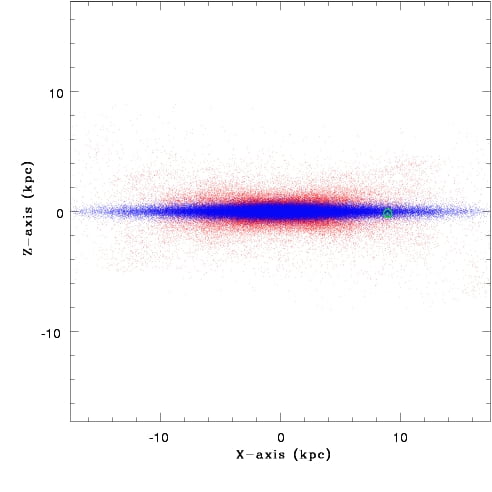Astronomer Dr Kenji Bekki of the International Centre for Radio Astronomy Research (ICRAR) in Perth worked with international collaborators to simulate a merger between a smaller Galaxy and an infant Milky Way some nine billion years ago.
“Our computer model shows a distinct bar-shape in a portion of our Galaxy called the thick disk. If observed, this bar would be clear evidence for a merger taking place in the early history of the Milky Way,” says Dr Bekki, who is based at The University of Western Australia node of ICRAR.
The Milky Way is shaped like two fried eggs placed back to back, where the yolks are a puffy collection of older stars called the bulge. The whites are a bright collection of younger stars known as the thin disk. The thick disk is a puffed up version of the thin disk, but is ten times lighter.
Current ideas predict that the thick disk used to be shaped like the thin disk, but was ‘puffed up’ by a merger with a smaller galaxy. The thin disk we observe today was then slowly formed from other material in our Galaxy.
The idea that our Galaxy was shaped in this way by galactic merging has been around for about 30 years, but until now this hasn’t been directly testable. This research provides the best avenue yet to determine whether or not the merger actually occurred.
“If our predicted bar-shape is not detected within the thick disk, then we know it can’t have formed as early as we think. We would then need some new ideas for how our Galaxy came to look the way it does today,” says Dr Bekki.
“Detecting the shape of the thick disk involves working out the movement of individual stars, a lengthy painstaking process. From our vantage point within the thin disk of the Galaxy, it’s difficult for us to know exactly what shape our Galaxy is,” he adds.
Dr Bekki is building on work first started by ICRAR Director Professor Peter Quinn. “Galaxies like the Milky Way are thought to have been formed and evolve through a cascade of accretions and mergers with other galaxies – some large and some small. This is the now standard picture of structure formation in the Cold Dark Matter theory of the Universe. The remnants of some of these accretions and mergers can now be seen in the “fossil record” of our galaxy that we glimpse through the distribution of clumps and streams of old stars in the outskirts of the Milky Way,” says Quinn.
“The disk of the Milky Way is very delicate and can be easily be disturbed by mergers with even small companions. Some work I did with Jeremy Goodman in 1986 was the first to point this out. We thought that the thickness of the Milky Way disk could be caused by repeated small mergers over the lifetime of the Milky Way. Kenji has significantly improved on our calculations and has now uncovered some important new clues to the connection between the structure of the Milky Way and its past history of encounters with small and large companions.”

This image shows a side-on view of the simulated Milky Way. The thin disk is in blue and the thick disk in red. The green circle shows the location of the Solar System/Earth within the thin disk. Credit: Dr Kenji Bekki, ICRAR.
The published paper: “Origin of chemical and dynamical properties of the Galactic thick disk”